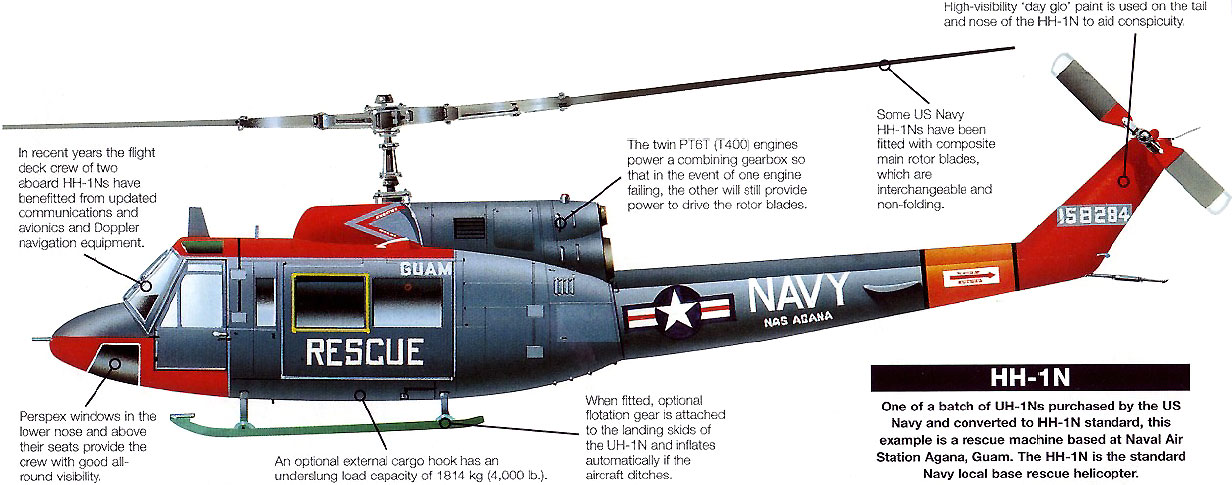USN Helicopters
The USN operates numerous helicopter fleets, primarily for ASW (Anti-Submarine Warfare) but also for SAR (Search and Rescue), logistics and general tasks. This section will not discuss US Marine Corps (USMC) helicopters which are covered in the amphibious section.
The Seasprite fulfilled the light ASW role, answering the specification for LAMPS I (Light Airborne Multi-Purpose System). The name is odd because the SH-2 is such a small platform that its ability to fulfil multi-purpose aspect of the title is questionable, although a hoist could be fitted and a slung load could be carried. The Seasprite was widely used throughout the Viet Nam war era, flying off the small decks of many US ships, but it was approaching retirement and due to be replaced by the SH-60B. Complications arose to this plan in the 1980s because of the 600 ship navy plan. The SH-2 was the only helicopter able to operate off the Knox class and older frigates as well as many of the early Oliver Hazard Perry ships (Short Hull). So the SH-2G ‘Super Seasprite’ was developed, historically these were sent immediately to the Reserves due to a shrinking fleet and only 24 were acquired (6 new and 18 conversions), in Northern Fury they all remain in the active fleet and 24 more older aircraft were converted for a fleet total of 48 ‘Super Seasprites’. The plan was further complicated due to the Gulf War in 1991, for deployment there, 16 SH-2Fs were fitted with forward looking infra-red (FLIR) cameras and other modifications, these remain in service as well and are known as the SH-2F(GW). In total there are 112 Seasprites are in the fleet and about a dozen held in readiness.
| Sqn | Name | Location | No. | Type | Remarks |
|---|---|---|---|---|---|
| HSL-31 | Arch Angels | NAS North Island | 12 | SH-2G | |
| HSL-32 | Invaders | NAS Norfolk | 12 | SH-2G | |
| HSL-33 | Seasnakes | NAS North Island | 12 | SH-2G | |
| HSL-38 | Seawolves | NAS Norfolk | 16 | SH-2F | Several Gulf War Mod |
| HSL-74 | Demon Elves | NAS Norfolk | 16 | SH-2F | Several Gulf War Mod |
| HSL-75 | Emerald Knights | NAS North Island | 16 | SH-2F | Several Gulf War Mod |
| HSL-84 | Thunderbolts | NAS Norfolk | 16 | SH-2F | Several Gulf War Mod |
| HSL-94 | Titans | NAS Norfolk | 12 | SH-2G |
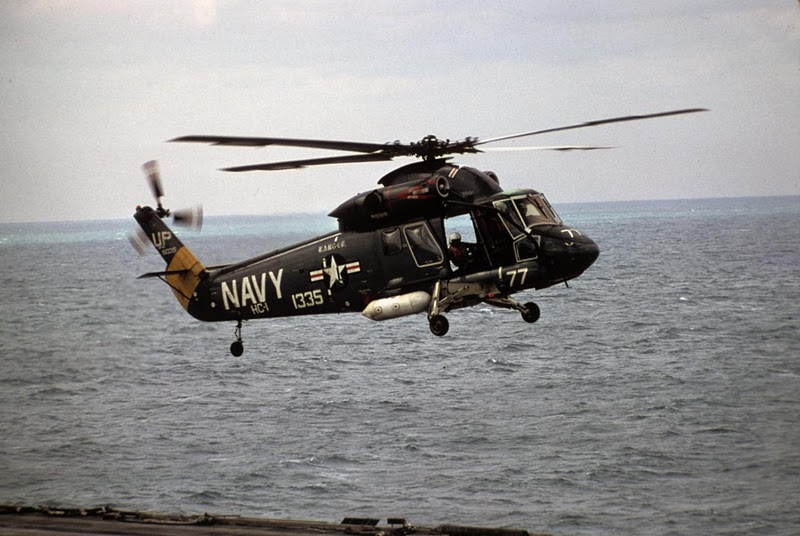
SH-3 Sea KingAt its peak the USN operated well over 300 of the powerful and amphibious SH-3 Sea King helicopters but is currently retiring the bulk of that fleet. The two roles remaining to the Sea King are:
ASW; where it is being replaced by the SH-60F Oceanhawk in the Carrier Air Wings (CVW). Both the Sea King and the new Oceanhawk differ from other US ASW helicopters by having dipping sonar, allowing them to use active sonar at depth near very noisy ships – like Aircraft Carriers.
SAR; (Search and Rescue) and general utility. The SAR task will be taken up by the HH-60H ‘Rescue Hawk’ but only on the CVWs and Special Forces squadrons. General duties and shore based SAR will be conducted by the last remaining 26 UH-3H Sea Kings and a variety of other means.
| Type | Sqn | Name | No | Location | Remarks |
|---|---|---|---|---|---|
| SH-3G | HC-1 | Fleet Angels | 8 | North Island | |
| HC-2 | Fleet Angels | 12 | Norfolk | ||
| 1 | Naples Italy | 6th Fleet VIP Tpt | |||
| VC-3 | Red Tails | 4 | Puerto Ricco | Target tower | |
| VC-5 | Checkertails | 5 | Cubi Pt Philippines | Target tower | |
| VC-8 | Redtails | 6 | Oceania | Target tower | |
| VX-1 | Pioneers | 2 | Patuxent River | Test pilot trg | |
| Not assigned | 3 | Pensacola | |||
| Not assigned | 3 | Cecil Fd | |||
| Not assigned | 3 | Key West | |||
| Not assigned | 2 | Jacksonville | |||
| Not assigned | 3 | Whidbey Is | |||
| Not assigned | 3 | Miramar | |||
| SH-3D | HS-5 | Nightdippers | 6 | CVW-7 | USS J.F. Kennedy |
| HS-7 | Dusty Dogs | 6 | CVW-3 | USS Eisenhower | |
| HS-9 | Sea Griffins | 6 | CVW-17 | USS Saratoga | |
| HS-11 | Dragon Slayers | 6 | CVW-1 | USS America | |
| HS-12 | Wyverns | 6 | CVW-5 | USS Independence | |
| HS-16 | Bullfrogs | 6 | CVW-2 | USS Constellation | |
| HS-17 | Neptune's Raiders | 6 | North Island | Deactivating | |
| HS-85 | Golden Gators | 6 | North Island | Reserve Sqn | |
| UH-3H | HC-1 | Fleet Angels | 8 | North Island | |
| HC-2 | Fleet Angles | 4 | Norfolk | ||
| HC-5 | Providers | 7 | Agana Japan | ||
| HC-11 | Gunbearers | 4 | North Island | ||
| HC-16 | Bullfrogs | 4 | Pensacola | ||
| HSL-51 | Warlords | 1 | Yokosuka Japan | 7th Fleet VIP Tpt |
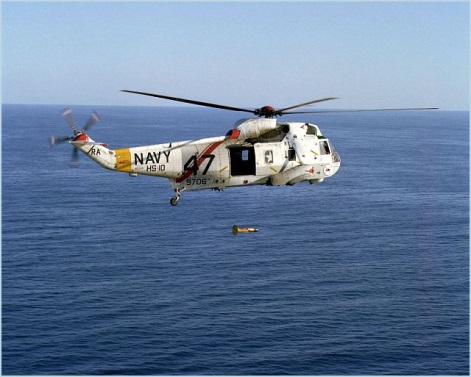
The very robust and capable Seahawk is the maritime variant of the armies UH-60 Blackhawk and its versatility was ideal for the Navy. Ideally the USN wanted to replace all (or most) helicopters with this one family of aircraft, but budgets got in the way of that idea, however because the Army, the USAF and the US Coast Guard are also adopting variants the pan-defence efficiencies may eventually allow that to happen. By 1994 the USN was acquiring three variants, all with the name Seahawk but unofficially with adopted names:
- SH-60B Seahawk, filling a LAMPS III role, these rugged and powerful ASW helicopter have modern and capable ASW computation and targeting systems, a Magnetic Anomaly Detector (MAD), 25 sonobuoys, a powerful search radar, FLIR and either air launched torpedoes or Penguin Anti-Ship Missiles (ASM). These are equipped with a RAST (Recovery Assist, Secure and Traverse) system to assist them landing on a small deck. In total, 181 SH-60B were produced.
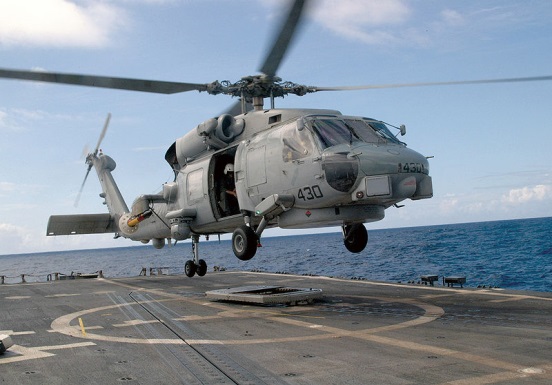
- SH-60F Oceanhawk, designed to operate off aircraft carriers, this model exchanges the RAST system, the MAD, the search radar and the onboard sonobouys for an active dipping sonar, enabling it to hunt submarines near the center of a very noisy task group. The Oceanhawk has only 6 sonobouys launched from an external mount. The USN procured 76 SH-60F but only 45 have been delivered by the start of Northern Fury.
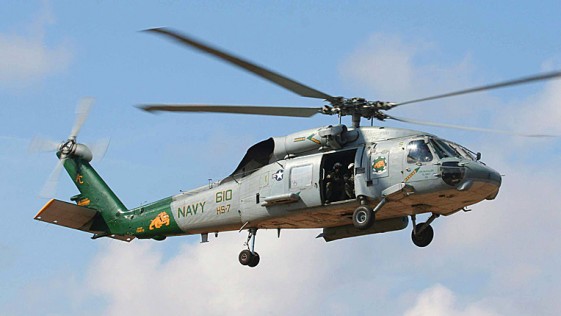
- HH-60H Rescue Hawk, primarily used by two Special Forces CSAR (Combat Search and Rescue) squadrons, this aircraft is based on the SH-60F but has many survivability features including electronic countermeasures, jammers and chaff/flare dispensers. It can fire the AGM-114 Hellfire missile. In addition to the CSAR squadrons, each HS (Helicopter ASW) squadron is equipped with two HH-60H to augment the six SH-60Fs. Only 42 of this type were produced.
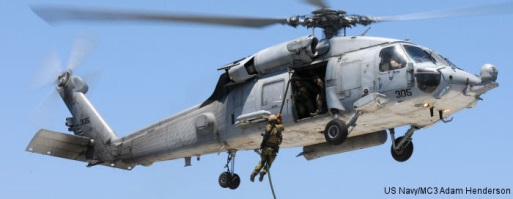
| Sqn | Name | Location | No. | Type | Remarks |
|---|---|---|---|---|---|
| HS-2 | Golden Falcons | CVW-9 | 6/2 | SH-60F/HH-60H | USS Nimitz |
| HS-3 | Tridents | CVW-8 | 6/2 | SH-60F/HH-60H | USS T Roosevelt |
| HS-4 | Black Knights | CVW-15 | 6/2 | SH-60F/HH-60H | USS Kitty Hawk |
| HCS-4 | Red Wolves | NAS Norfolk | 12 | HH-60H | |
| HCS-5 | Firehawks | NAS North Island | 12 | HH-60H | |
| HS-6 | Indians | CVW-11 | 6/2 | SH-60F/HH-60H | USS Abraham Lincoln |
| HS-4 | Eightballers | CVW-14 | 6/2 | SH-60F/HH-60H | USS Carl Vinson |
| HS-15 | Red Lions | CVW-6 | 6/2 | SH-60F/HH-60H | USS Enterprise |
| HS-16 | Nighthawks | CVW-10 | 6/2 | SH-60F/HH-60H | USS George Washington |
| HSL-34 | Greencheckers | NAS Norfolk | 18 | SH-60B | FRS |
| HSL-35 | Magicians | NAS North Island | 14 | SH-60B | |
| HSL-36 | Lamplighters | NAS Mayport | 12 | SH-60B | |
| HSL-37 | Easy Riders | NAS North Island | 14 | SH-60B | |
| HSL-40 | Airwolves | NAS Mayport | 13 | SH-60B | |
| HSL-42 | Proud Warriors | NAS Mayport | 13 | SH-60B | |
| HSL-43 | Battle Cats | NAS North Island | 14 | SH-60B | |
| HSL-44 | Swamp Foxes | NAS Mayport | 13 | SH-60B | |
| HSL-45 | Wolfpack | NAS North Island | 14 | SH-60B | |
| HSL-46 | Grandmasters | NAS Mayport | 13 | SH-60B | |
| HSL-47 | Saberhawk | NAS North Island | 14 | SH-60B | |
| HSL-48 | Vipers | NAS Mayport | 13 | SH-60B | |
| HSL-60 | Jaguars | NAS Mayport | 16 | SH-60B | FRS |
CH/UH/HH-46 Sea KnightThese twin engine medium lift helicopters fulfill a number of roles across the Navy. The CH-46D airframe is shared with the USMC and is used for general cargo transport. The UH-46D is used for cargo transport, primarily off of replenishment ships. The HH-46D are used as SAR helicopters, primarily off fixed USN bases
| Sqn | Name | Location | CH-46D | UH-46D | HH-46D |
|---|---|---|---|---|---|
| HC-3 | Pack Rats | NAS North Island | 10 | 6 | |
| HC-5 | Providers | NAS Agana Japan | 12 | ||
| HC-6 | Chargers | NAS Norfolk | 15 | 5 | |
| HC-8 | Dragonwales | NAS Norfolk | 12 | 5 | |
| HC-11 | Gunbearers | NAS North Island | 24 | 4 | 12 |
| Totals | 61 | 26 | 18 |
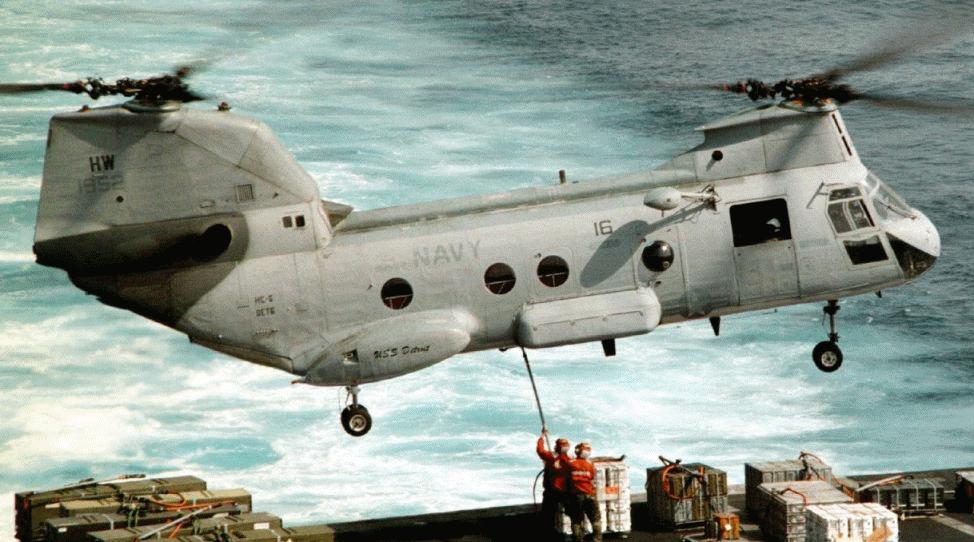
MH-53E Sea DragonThe USN operates the MH-53E primarily in the mine clearing role but these aircraft are also very capable heavy lift helicopters. All three squadrons are located at NAS Norfolk but are deployable worldwide via C-5 Galaxy to any trouble spot. HM-14 is affiliated with Pacific Fleet.
| Sqn | Name | Location | No. | Type | Remarks |
|---|---|---|---|---|---|
| HM-12 | Hawlin Hogs | NAS Norfolk | 12 | MH-53E | FRS |
| HM-14 | Vanguard | NAS Norfolk | 18 | MH-53E | |
| HM-15 | Blackhawks | NAS Norfolk | 18 | MH-53E |
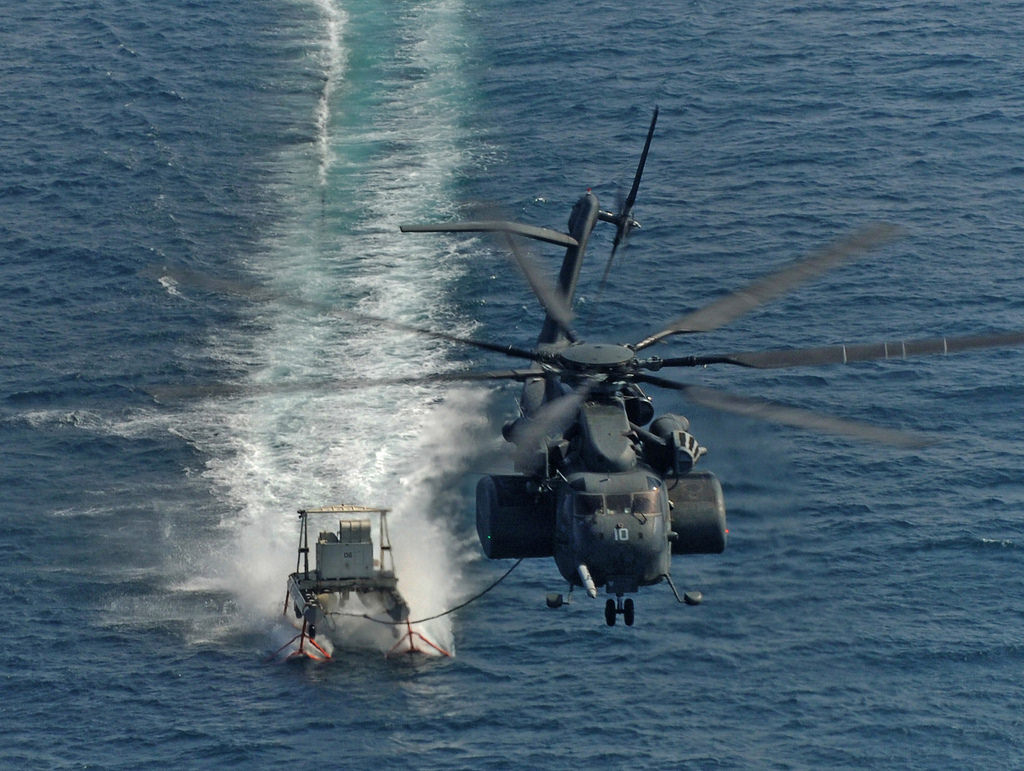
The Navy operates about 25 UH-1N Iroquois (Twin Huey) light utility helicopters in the SAR, VIP transport and utility roles. As the USMC retires their UH-1N in favour of the UH-1Y, the USN is able to absorb more and deploy them as needed.
